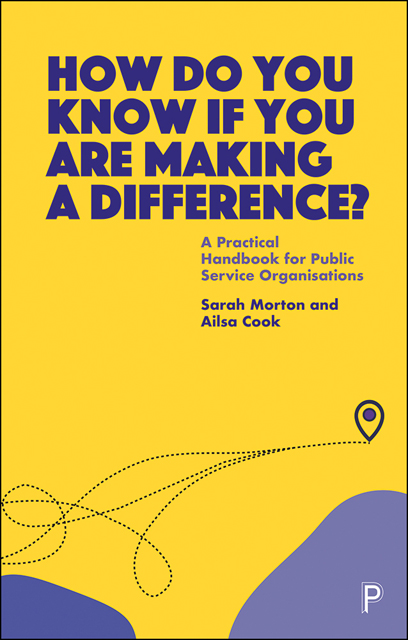 How Do You Know If You Are Making a Difference?
How Do You Know If You Are Making a Difference? Book contents
- Frontmatter
- Dedication
- Contents
- List of figures and tables
- Acknowledgements
- Preface
- 1 Why is it so hard to know if you are making a difference?
- 2 Why complexity thinking can help you understand public services
- 3 What data and evidence do you need to see what difference you are making?
- 4 Embrace the complex contex
- 5 Embrace the complex context
- 6 Clarify the change you want to see
- 7 Get going on your data, evidence and feedback improvement journey
- 8 Tracking progress towards outcomes and impacts
- 9 Telling the story of the difference your work makes
- 10 Using this approach in different contexts and sectors
- 11 Becoming an outcome- and impact-focused organisation
- References
- Index
11 - Becoming an outcome- and impact-focused organisation
Published online by Cambridge University Press: 20 June 2023
- Frontmatter
- Dedication
- Contents
- List of figures and tables
- Acknowledgements
- Preface
- 1 Why is it so hard to know if you are making a difference?
- 2 Why complexity thinking can help you understand public services
- 3 What data and evidence do you need to see what difference you are making?
- 4 Embrace the complex contex
- 5 Embrace the complex context
- 6 Clarify the change you want to see
- 7 Get going on your data, evidence and feedback improvement journey
- 8 Tracking progress towards outcomes and impacts
- 9 Telling the story of the difference your work makes
- 10 Using this approach in different contexts and sectors
- 11 Becoming an outcome- and impact-focused organisation
- References
- Index
Summary
We asked some of the organisations and teams we work with to share their insights into the way of working we have set out in this book. This chapter shares their thoughts, resources they find helpful, and other resources we often recommend. We also explain the software OutNav, which we have developed to support the approach.
We would like to acknowledge Richard Darke, Edinburgh & Lothians Greenspace Trust; Julie Gardner, Thistle Foundation; Eleanor MacKillop, Wales Centre for Public Policy; Gill Toms, Bangor University; Catriona Windle, Health All Round; and Alex Perry, Helen Berry, Grace Robertson and Simon Bradstreet from Matter of Focus for their suggestions.
Advice from other organisations on the journey
Stick with the messy, emergent stuff over the first few months because you will gradually get a handle on things and a plan will start to take shape. But this does require several meetings and thinking space, so time needs to be allocated. I would also recommend trying to include all the important voices right from the start.
It will take time to develop your map and pathways.
If possible, use the approach to think about impact before it happens – as you are developing a project.
Be pragmatic about collecting data – the more it is built into everyday practice, the easier it will be.
Try out new methods (like reflective impact logs) on specific projects and then see whether they can be rolled out more widely.
Start trying to weave a narrative into tracking early on. Once the narrative is taking shape, it is easier to think about the outcomes and how to capture them – how to make the story convincing.
Present your emerging impact to management committees and trustees.
It’s a great way of presenting your organisation’s achievements. Before, everything just got lost in the annual plethora of funding reports – now, it’s much more dynamic than an annual report and more impressive.
It takes time to embed the discipline of this approach into your work, but we are committed to doing so and it very much informs how we think and plan.
Resources to help with evaluation thinking
AMEC taxonomy of evaluation
This taxonomy table breaks down public communication into several stages such as inputs, outputs and impacts, and suggests ways to think analytically about each stage.
- Type
- Chapter
- Information
- How Do You Know If You Are Making a Difference?A Practical Handbook for Public Service Organisations, pp. 162 - 169Publisher: Bristol University PressPrint publication year: 2022


